| Arthur Louis Aaron |
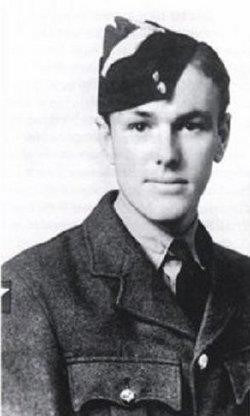 |
Rank:
Service No.:
Awards:
Date of Birth:
Date of Death:
Age:
Regiment:
Cemetery:
Add. Information: |
Flight Sergeant (Pilot)
1458181
Victoria Cross
Distinguished Flying Medal
05 March 1922, Leeds
13 August 1943, Bône Hospital, Algeria
21
218 (Gold Coast) Sqdn. Royal Air Force Volunteer Reserve
Bône War Cemetery, Annaba, Algeria
Son of Mr. and Mrs. B. Aaron,
of Gledhow, Leeds, Yorkshire. |
The Air Ministry reports on 5th November 1943:
The King has been graciously pleased to confer the Victoria Cross on the undermentioned airman in recognition of most conspicuous bravery:
1458181 Acting Flight Sergeant Arthur Louis Aaron, D. F. M., Royal Air Force Volunteer Reserve, No. 218 Squadron (deceased).
On the night of 12 August 1943, Flight Sergeant Aaron was captain and pilot of a Stirling aircraft detailed to attack Turin. When approaching to attack, the bomber received devastating bursts of fire from an enemy fighter. Three engines were hit, the windscreen shattered, the front and rear turrets put out of action and the elevator control damaged, causing the aircraft to become unstable and difficult to control. The navigator was killed and other members of the crew were wounded.
A bullet struck Flight Sergeant Aaron in the face, breaking his jaw and tearing away part of his face. He was also wounded in the lung and his right arm was rendered useless. As he fell forward over the control column, the aircraft dived several thousand feet. Control was regained by the flight engineer at 3,000 feet. Unable to speak, Flight Sergeant Aaron urged the bomb aimer by signs to take over the controls. Course was then set southwards in an endeavour to fly the crippled bomber, with one engine out of action, to Sicily or North Africa.
Flight Sergeant Aaron was assisted to the rear of the aircraft and treated with morphia. After resting for some time he rallied and, mindful of his responsibility as captain of aircraft, insisted on returning to the pilot's cockpit, where he was lifted into his seat and had his feet placed on the rudder bar. Twice he made determined attempts to take control and hold the aircraft to its course but his weakness was evident and with difficulty he was persuaded to desist. Though in great pain and suffering from exhaustion, he continued to help by writing directions with his left hand.
Five hours after leaving the target the petrol began to run low, but soon afterwards the flare path at Bone airfield was sighted. Flight Sergeant Aaron summoned his failing strength to direct the bomb aimer in the hazardous task of landing the damaged aircraft in the darkness with undercarriage retracted. Four attempts were made under his direction; at the fifth Flight Sergeant Aaron was so near to collapsing that he had to be restrained by the crew and the landing was completed by the bomb aimer.
Nine hours after landing, Flight Sergeant Aaron died from exhaustion. Had he been content, when grievously wounded, to lie still and conserve his failing strength, he would probably have recovered, but he saw it as his duty to exert himself to the utmost, if necessary with his last breath, to ensure that his aircraft and crew did not fall into enemy hands. In appalling conditions he showed the greatest qualities of courage, determination and leadership and, though wounded and dying, he set an example of devotion to duty which has seldom been equalled and never surpassed. |
 |
| George Sanders |
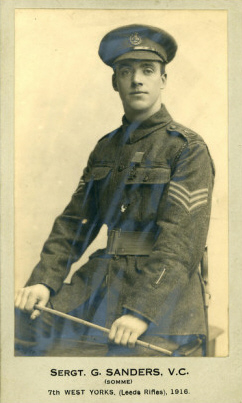 |
Rank:
Service No.:
Award:
Date of Birth:
Date of Death:
Age:
Regiment:
Cemetery:
Add. Information: |
Corporal (Later Captain)
Victoria Cross
08 July 1894, 7 Thornton Place, New Wortley, Leeds
04 April 1950, Leeds
56
1/6th Bn. West Yorkshire Regiment
Cottingley Crematorium, Leeds
Son of Thomas and Amy Sanders |
On 1 July 1916 near Thiepval, France, Sanders' battalion were in reserve but late the afternoon the battalion was ordered to advance into the Schwaben Redoubt which had been captured earlier in the day and was being counter-attacked. After an advance into the enemy's trenches, Corporal Sanders found himself isolated with a party of 30 men. For 36 hours Sanders' small force held off German attacks before being relieved and leading the 19 survivors back to the British lines.
The London Gazette published on 9 September 1916:
For most conspicuous bravery. After an advance into the enemy's trenches, he found himself isolated with a party of thirty men. He organised his defences, detailed a bombing party, and impressed on his men that his and their duty was to hold the position at all costs.
Next morning he drove off an attack by the enemy and rescued some prisoners who had fallen into their hands. Later two strong bombing attacks were beaten off. On the following day he was relieved after showing the greatest courage, determination and good leadership during 36 hours under very trying conditions.
All this time his party was without food and water, having given all their.water to the wounded during the first night. After the relieving force was firmly established, he brought his party, nineteen strong, back to our trenches. |
 |
| David Philip Hirsch |
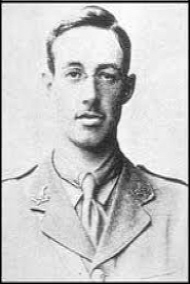 |
Rank:
Service No.:
Awards:
Date of Birth:
Date of Death:
Age:
Regiment:
Cemetery:
Add. Information: |
Captain
Victoria Cross
28 December 1896, Leeds
23 April 1917, Wancourt, France
20
4th Bn. Yorkshire Regiment
Arras War Memorial, France
Son of Harry and Edith Hirsch,
of Weetwood Grove, Leeds. |
On 23rd April 1917 near Wancourt, France, he led an attack on enemy positions. Having arrived at the first objective, Capt. Hirsch, although already twice wounded, returned over fire-swept slopes to satisfy himself that the defensive flank was being established. Machine gun fire was so intense that it was necessary for him to be continuously up and down the line encouraging his men to dig and hold the position. He continued to encourage his men by standing on the parapet and steadying them in the face of machine gun fire and counterattack until he was killed.
His body was not recovered after the action, and he is commemorated on the Arras Memorial. |
| Edward McKenna |
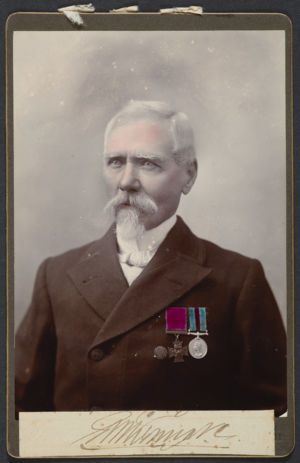 |
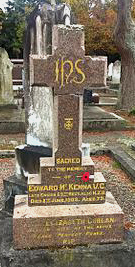 |
Rank:
Service No.:
Awards:
Date of Birth:
Date of Death:
Age:
Regiment:
Cemetery:
Add. Information: |
Colour Serjeant
Victoria Cross
15 February 1827, Leeds
08 June 1908, Palmerston North, New Zealand
81
65th Regiment of Foot (later the 1st Bn, York and Lancaster Regiment)
Terrace End Cemetery, Palmerston North, New Zealand
|
| The London Gazette published on 19 January 1864:
For gallant conduct at the engagement near Cameron-town, New Zealand, on the 7th. of September, 1863, after both his officers, Captain Swift and Lieutenant Butler, had been shot, in charging through the position of an enemy heavily outnumbering him, and drawing off his small force, consisting of two Serjeants, one bugler, and thirty-five men, through a broken and rugged country, with the loss of but one man killed, and another missing. Lieutenant General Cameron, C. B., Commanding Her Majesty's Forces in that colony, reports that, in Colour-Serjeant MacKenna, the detachment found a Commander whose coolness, intrepidity, and judgment, justified the confidence placed in him by the soldiers brought so suddenly under his command. |
 |
| William Boynton Butler |
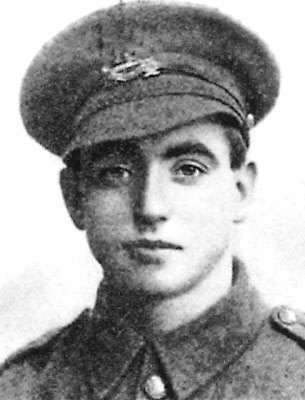 |
Rank:
Service No.:
Awards:
Date of Birth:
Date of Death:
Age:
Regiment:
Cemetery:
Add. Information: |
Private
Victoria Cross
Croix de Guerre (France)
20 November 1894
25 March 1972, Leeds General Infirmary
77
17th Bn. The West Yorkshire Regiment (The Prince of Wales's Own)
Hunslet Cemetery, Leeds
Husband of Clara Butler, nee Johnson. |
Butler was 22 years old when the following deed took place on 6 August 1917 east of Lempire, France for which he was awarded the VC:
For most conspicuous bravery when in charge of a Stokes gun in trenches which were being heavily shelled. Suddenly one of the fly-off levers of a Stokes shell came off and fired the shell in the emplacement. Private Butler picked up the shell and jumped to the entrance of the emplacement, which at that moment a party of infantry were passing. He shouted to them to hurry past as the shell was going off, and turning round, placed himself between the party of men and the live shell and so held it till they were out of danger. He then threw the shell on to the parados, and took cover in the bottom of the trench. The shell exploded almost on leaving his hand, greatly damaging the trench. By extreme good luck Private Butler was contused only. Undoubtedly his great presence of mind and disregard of his own life saved the lives of the officer and men in the emplacement and the party which was passing at the time. |
 |
| Jack White |
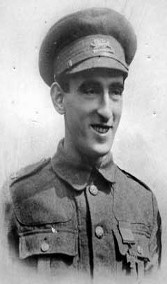 |
Rank:
Service No.:
Awards:
Date of Birth:
Date of Death:
Age:
Regiment:
Cemetery:
Add. Information: |
Private
18105
Victoria Cross
23 December 1896, Leeds
27 November 1949, Salford, Greater Manchester
52
6th Bn. The King's Own (Royal Lancaster) Regiment
Jewish Cemetery, Blackley, Manchester
He was born as Jacob Weiss of Russian Jewish parents,
Isaac and Olga (nee Braverman) Weiss. |
On 7th/8th March 1917 on the Dialah River, Mesopotamia, Jack, during an attempt to cross a river saw the two Pontoons ahead of him come under heavy machine-gun fire, with disastrous results. When his own Pontoon had reached midstream, with every man except himself either dead or wounded, finding that he was unable to control the Pontoon, Pte. White promptly tied a telephone wire to the Pontoon, jumped overboard, and towed it to the shore, thereby saving an officer's life and bringing to land the rifles and equipment of the other men in the boat, who were either dead or dying. |
| Frederick McNess |
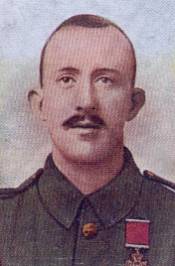 |
Rank:
Service No.:
Awards:
Date of Birth:
Date of Death:
Age:
Regiment:
Cemetery:
Add. Information: |
Lance Sergeant
Victoria Cross
22 January 1892, Bramley
04 May 1956, Boscombe, Dorset
64
1st Bn. Scots Guards
Bournemouth Crematorium and North Cemetery
|
On 15 September 1916 near Ginchy, France, during a period of severe fighting, Lance-Sergeant McNess led his men with great dash in the face of heavy shell and machine-gun fire. When the first line of the enemy trenches was reached, it was found that the left flank was exposed and that the enemy were bombing down the trench. McNess then organised and led a counter-attack and, although he was very severely wounded in the neck and jaw, did not give up. Finally he established a "block" and continued encouraging his men and throwing bombs until exhausted by loss of blood.
He later achieved the rank of sergeant. The severe nature of his wounds left Ness in lifelong pain which eventually led him to take his own life. |
 |
| Lawrence Calvert |
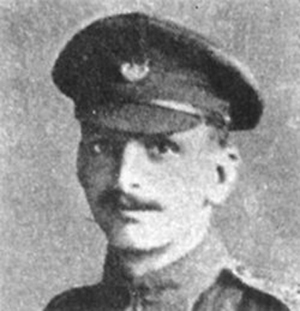 |
Rank:
Service No.:
Awards:
Date of Birth:
Date of Death:
Age:
Regiment:
Cemetery:
Add. Information: |
Serjeant
Victoria Cross
Order of Leopold (Belgium)
Military Medal
16 February 1892
06 July 1964, Dagenham
72
5th Bn. King's Own Yorkshire Light Infantry
South Essex Crematorium, Upminster
Son of George and Beatrice Calvert,
of Great Wilson Street, Hunslet, Leeds |
During the hottest of the fighting on the Rheims front in September 1916, Sgt Calvert was able to do great execution with a machine gun, and when his post was visited it was found that he was the only survivor of the machine gun crew, while ranged before the gun were piles of dead Germans, silent and eloquent evidence of the coolness and steadiness with which the gun had been operated. He was awarded the Military Medal for this action.
On 12th September 1918, at Havrincourt, France, when alone and single handed, he was rushing forward against the machine-gun team, bayoneted three and shot four. His valour and determination in capturing single-handed two machine guns and killing the crews there of enabled the ultimate objective to be won. It follows the award of the VC. |
 |
| Albert Mountain |
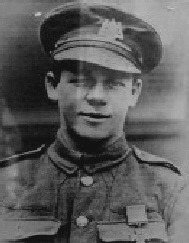 |
Rank:
Service No.:
Awards:
Date of Birth:
Date of Death:
Age:
Regiment:
Cemetery:
Add. Information: |
Serjeant
Victoria Cross
Croix de guerre (France)
Médaille militaire (France)
19 April 1897, Leeds
07 January 1967
69
15/17th Bn. The Prince of Wales's Own (West Yorkshire Regiment)
Lawnswood Crematorium, Leeds
|
| The London Gazette published on 07 June 1918: For most conspicuous bravery and devotion to duty during an enemy attack, when his company was in an exposed position on a sunken road, having hastily dug themselves in. Owing to the intense artillery fire, they were obliged to vacate the road and fall back. The enemy in the meantime was advancing in mass preceded by an advanced patrol about 200 strong. The situation was critical, and volunteers for a counter-attach were called for. Sjt. Mountain immediately stepped forward, and his party of ten men followed him. He then advanced on the flank with a Lewis gun and brought enfilade fire to bear on the enemy patrol, killing about 100.
In the meantime the remainder of the Company made a frontal attack, and the entire enemy patrol v/as cut up and thirty prisoners taken.
At this time the enemy main body appeared and the men, who were numerically many times weaker than the enemy, began to waver.
Sjt. Mountain rallied and organised his party and formed a defensive position from which to cover the retirement of the rest of the Company and the prisoners. With this party of one Non-commissioned Officer and four men he successfully held at bay 600 of the enemy for half an hour, eventually retiring and rejoining his Company.
He then took command of the flank post of the Battalion which was in the air," and held on there for 27 hours until finally surrounded by the enemy.
Sjt. Mountain was one of the few who managed to fight their way back.
His supreme fearlessness and initiative undoubtedly saved the whole situation. |
 |
| Alfred Atkinson |
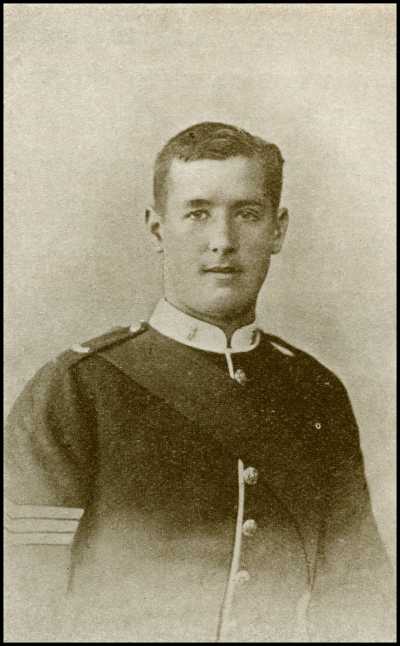 |
Rank:
Service No.:
Awards:
Date of Birth:
Date of Death:
Age:
Regiment:
Cemetery:
Add. Information: |
Sergeant
3264
Victoria Cross
06 February 1874, Leeds
21 February 1900, Paardeberg, Transvaal
26
1st Battalion, The Princess of Wales’s Own (Yorkshire Regiment)
Gruisbank British Cemetery, Paardeberg
Son of James Harland Atkinson and Margaret Atkinson, nee Mansfield. |
| The London Gazette published on 08 August 1902: No. 3264 Sergeant A. Atkinson, Yorkshire Regiment.
During the battle of Paardeburg, 18th February, 1900, Sergeant A. Atkinson, 1st Battalion Yorkshire Regiment, went out seven times, under heavy and close fire, to obtain water for the wounded. At the seventh attempt he was wounded in the head, and died a few days afterwards. |
| Charles Burley Ward |
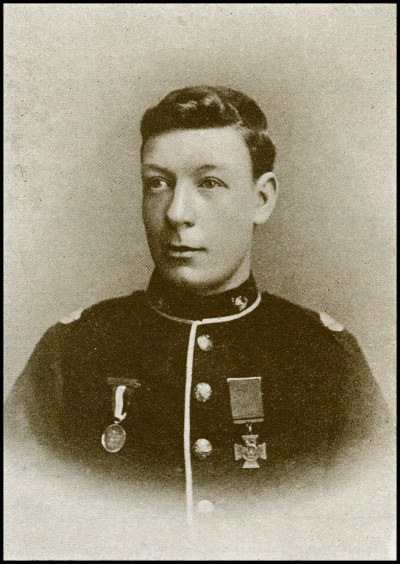 |
Rank:
Service No.:
Awards:
Date of Birth:
Date of Death:
Age:
Regiment:
Cemetery:
Add. Information: |
Private
Victoria Cross
10 July 1877, Leeds
30 December 1921, Bridgend, Glamorgan
44
2nd Bn. The King's Own Yorkshire Light Infantry
St Mary's Churchyard, Cardiff
Son of George Ward. |
| The London Gazette published on 28 September 1900: On the 26th June, 1900, at Lindley, a picquet cf the Yorkshire Light Infantry was surrounded on three sides by about 500 Boers, at close quarters. The two Officers were wounded and all but six of their men were killed or wounded. Private Ward then volunteered to take a message asking for reinforcements to the Signalling Station about 150 yards in the rear of the post. His offer was at first refused owing to the practical certainty of his being shot but, on his insisting, he was allowed to go. He got across untouched through a storm of shots from each flank, and, having delivered his message, he voluntarily returned from a place of absolute safety, and recrossed the fire-swept ground to assure his Commanding Officer that the message had been sent.
On this occasion he was severely wounded. But for this gallant action the post would certainly have been captured. |
 |
| John Pearson |
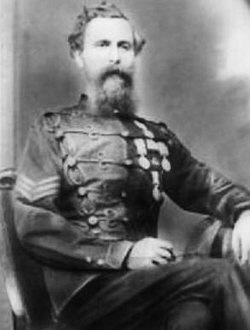 |
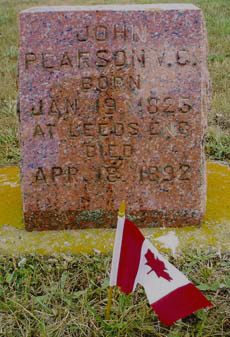 |
Rank:
Service No.:
Awards:
Date of Birth:
Date of Death:
Age:
Regiment:
Cemetery:
Add. Information: |
Private
861
Victoria Cross
19 January 1825, Leeds
18 April 1892, Lion's Head, Bruce County, Ontario, Canada
67
8th Hussars (The King's Royal Irish)
Eastnor Township Cemetery, Lion's Head
Husband of Selina Smart. |
| The London Gazette published on 28 January 1859: Selected for the Victoria Cross by their companions in the gallant charge made by a squadron of the Regiment at Gwalior, on the 17th of June, 1858, when, supported by a division of the Bombay Horse Artillery, and Her Majesty's 95th Regiment, they routed the enemy, who were advancing against Brigadier Smith's position, charged through the rebel camp into two batteries, capturing and bringing into their camp two of the enemy's guns, under a heavy and converging fire from the Fort and Towa.
(Field Force Orders by Major-General Sir Hugh Henry Rose, G. C. B., Commanding Central India Field Force, dated Camp, Gwalior, 28th June, 1858.)
|
| Charles Hull |
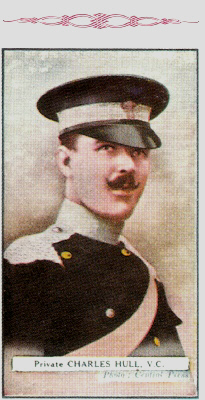 |
Rank:
Service No.:
Awards:
Date of Birth:
Date of Death:
Age:
Regiment:
Cemetery:
Add. Information: |
Private (Shoeing-Smith)
1053
Victoria Cross
24 July 1890, Harrogate
13 February 1953, Leeds
62
21st Lancers
Woodhouse Lane Cemetery, Leeds
Son of Mr. and Mrs. John Hull. |
| The London Gazette published on 03 March 1916: For most conspicuous bravery. When under close fire of the enemy, who were within a few yards, he rescued Captain G. E. D. Learoyd, whose horse had been shot, by taking him up behind him and galloping into safety. Shoeing-Smith Hull acted entirely on his own initiative, and saved his officer's life at the imminet risk of his own. |
| Harry Daniels |
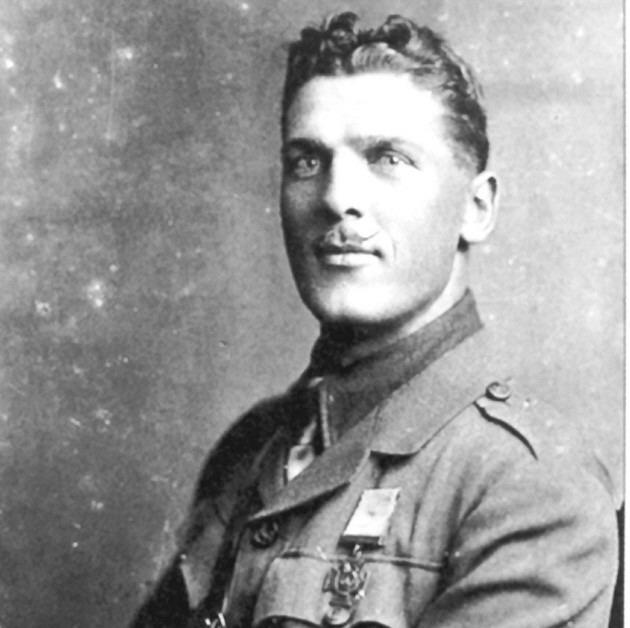 |
Rank:
Service No.:
Awards:
Date of Birth:
Date of Death:
Age:
Regiment:
Cemetery:
Add. Information: |
Company Sergeant-Major
9665
Victoria Cross
Military Cross
13 December 1884, Wymondham, Norfolk
13 December 1953, Leeds
69
2nd Bn. The Rifle Brigade (Prince Consort's Own)
Lawnswood Crematorium, Leeds
Son of William Daniels and Elizabeth Daniels, nee Snelling. |
| The London Gazette published on 27 April 1915: His Majesty the KING has been graciously pleased to approve of the grant of the Victoria Cross to the undermentioned Warrant Officer, non-commissioned officer, and men for their conspicuous acts of bravery and devotion to duty whilst serving with the Expeditionary Force:
No. 9665 Company Serjeant-Major Harry Daniels, 2nd Battalion, The Rifle Brigade (The Prince Consort's Own)
No. 3697 Acting Corporal Cecil Reginald Noble, late 2nd Battalion, The Rifle Brigade (The Prince Consort's Own).
For most conspicuous bravery on 12th March, 1915, at Neuve Chapelle. When their battalion was impeded in the advance to the attack by wire entanglements, and subjected to a very severe machine-gun fire, these two men voluntarily rushed in front and succeeded in cutting the wires. They were both wounded at once, and Corporal Noble has since died of his wounds. |
 |
| John Crawshaw Raynes |
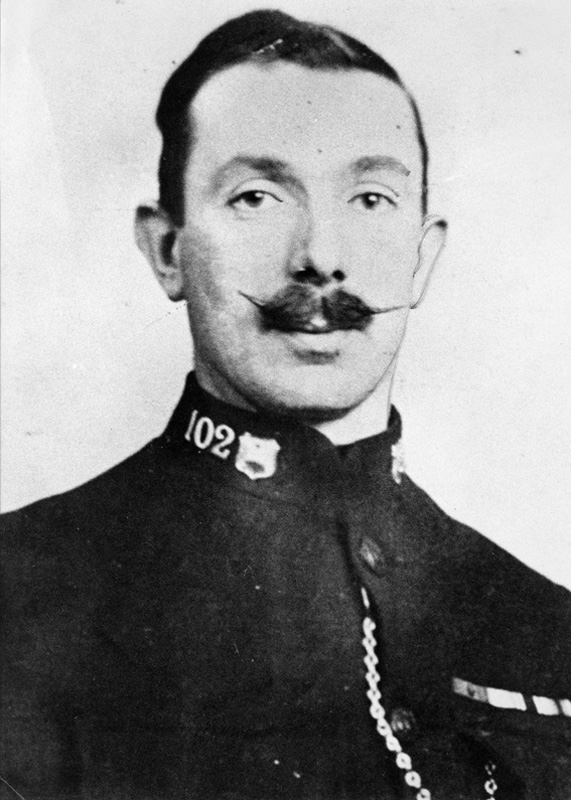 |
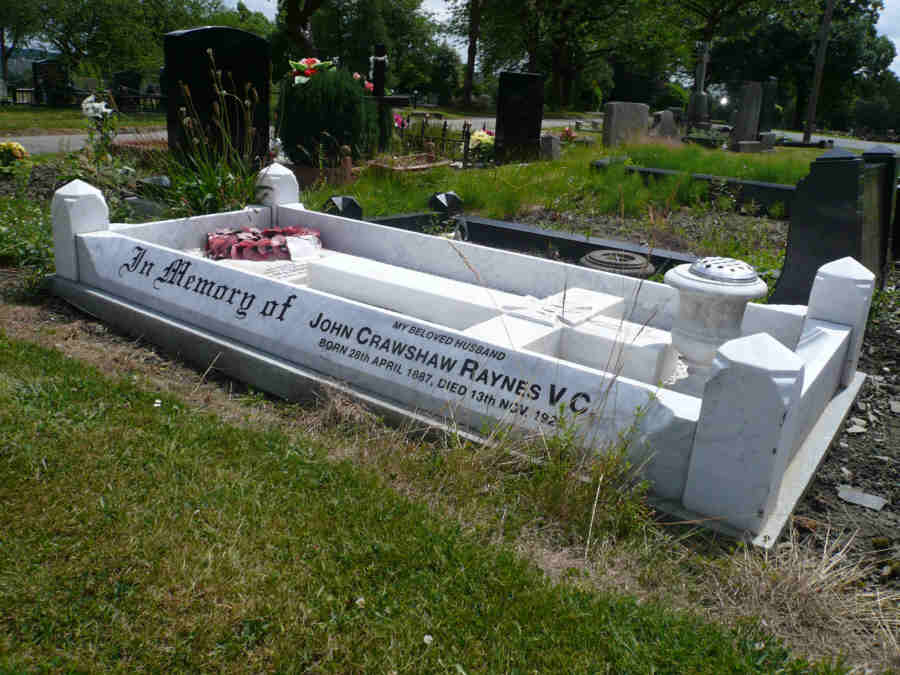 |
Rank:
Service No.:
Awards:
Date of Birth:
Date of Death:
Age:
Regiment:
Cemetery:
Add. Information: |
Battery Sergeant Major
36830
Victoria Cross
28 April 1887, Sheffield
12 November 1929, Leeds
42
"A" Battery, 71st Brigade Royal Field Artillery
Harehills Cemetery, Leeds
Son of Stephen Henry Raynes
and Hannah Elizabeth Crawshaw. |
| The London Gazette published on 18 November 1915: 36830 Acting-Serjeant John Crawshaw Raynes, " A " Battery, 71st Brigade, Royal Field Artillery.
For most conspicuous bravery and devotion to duty.
On llth October, 1915, at Fosse 7 de Bethune, his battery was being heavily bombarded by armour-piercing and gas shells. On "Cease fire" being ordered Serjeant Raynes went out under an intense shell fire to assist Serjeant Ayres who was lying wounded forty yards away. He bandaged him, and returned to his gun when it was again ordered into action. A few minutes later "Cease fire" was again ordered owing to the intensity of the enemy's fire, and Serjeant Raynes, calling on two gunners to help him - both of whom were killed shortly afterwards - went out and carried Serjeant Ayres into a dug-out. A gas shell burst at the mouth of the dugout, and Serjeant Raynes once more ran across the open, fetched his own smoke helmet, put it on Serjeant Ayres and then, himself badly gassed, staggered back to serve his gun. On 12th October, 1915, at Quality Street, a house was knocked down by a heavy shell, four men being buried in the house and four in the cellar. The first man rescued was Serjeant Raynes, wounded in the head and leg, but he insisted on remaining under heavy shell fire to assist in the rescue of all the other men. Then, after having his wounds dressed, he reported himself immediately for duty with his battery, which was again being heavily shelled. |
 |
| Wilfred Edwards |
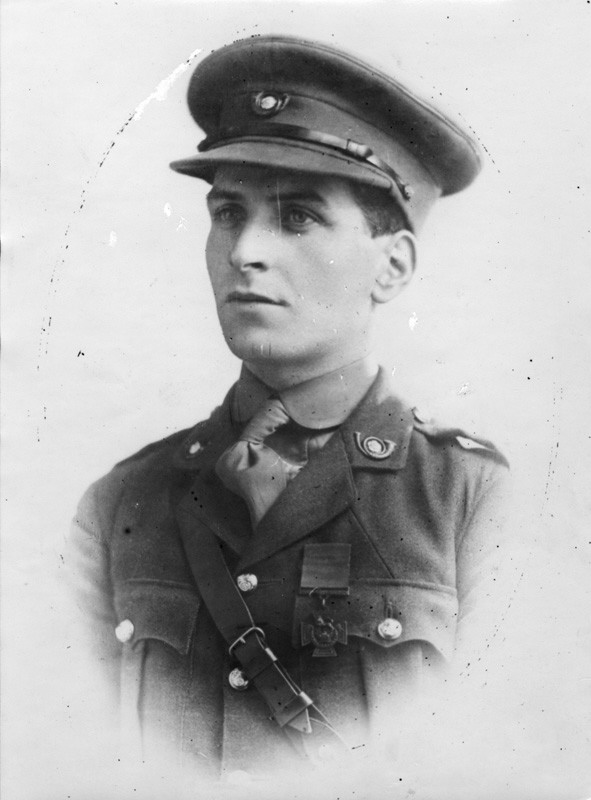 |
Rank:
Service No.:
Awards:
Date of Birth:
Date of Death:
Age:
Regiment:
Cemetery:
Add. Information: |
Private
13303
Victoria Cross
16 February 1893, Norwich, Norfolk
04 January 1972, Leeds
78
7th Bn. The King's Own Yorkshire Light Infantry
Upper and Lower Wortley Cemetery, Leeds
|
| The London Gazette published on 14 September 1917: No. 13303 Pte. Wilfrid Edwards, K. O. York. L. I. (Leeds).
For most conspicious bravery when under heavy machine gun and rifle fire from a strong concrete fort. Having lost all his company officers, without hesitation he dashed forward at great personal risk, bombed through the loopholes, surmounted the fort, and waved to his company to advance. By his splendid example he saved a most critical situation at a time when the whole battalion was held up and a leader urgently needed. Three officers and thirty other ranks were taken prisoner by him in the fort. Later, Pte. Edwards did most valuable work as a runner, and he eventually guided most of the battalion out through very difficult ground. Throughout he set a splendid personal example to all, and was utterly regardless of danger. |
 |
| Arthur Poulter |
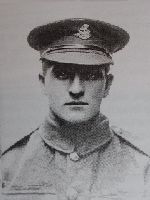 |
Rank:
Service No.:
Awards:
Date of Birth:
Date of Death:
Age:
Regiment:
Cemetery:
Add. Information: |
Private
24066
Victoria Cross
16 December 1893, East Witton, North Yorkshire
29 August 1956, Leeds
62
1/4th Bn. Duke of Wellington's (West Riding) Regiment
New Wortley Cemetery, Leeds
|
| The London Gazette published on 28 June 1918: No. 24066 Pte. Arthur Poulter, W. Hid. R. (Wortley, Leeds).
For most conspicuous bravery when acting as a stretcher-bearer.
On ten occasions Pte. Poulter carried 7 badly wounded men on his back to a safer locality, through a particularly heavy artillery and machine-gun barrage. Two of these were hit a second time whilst on his back. Again, after a withdrawal over the river had been ordered, Pte. Poulter returned in full view of the enemy who were advancing, and carried back another man who had been left behind wounded. Her bandaged up over forty men under fire, and his conduct throughout the whole day was a magnificent example to all ranks. This very gallant soldier was subsequently seriously wounded when attempting another rescue in the face of the enemy. |
|
|
|
|





